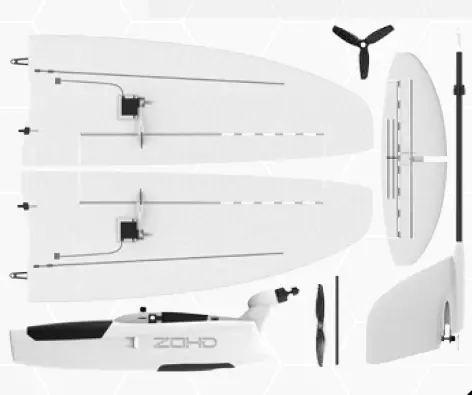
ZOHD Drift FPV Glider User Guide
Description of ZOHD DRIFT:
Brand Name: ZOHD Item Name: DRIFT Material: High Quality EPP Wingspan: 877mm (34.52″ ) Length : 688mm (27.08″) Recommended take off weight: 240-3209
OPTION A (2S Version)
Motor: 1406-2600KV ESC: 30A w/5V 2A BEC Servos : 4.3g*2, 8g*1 Propeller: 2 blade 5×5 Recommended Battery: Lipo 2S 900-1500mAh
ZOHD Lionpack 18650 2S1P 3500mAh
OPTION B (3S Version)
Motor: 1406-2600KV ESC: 30A w/5V 2A BEC Servos: 4.3g *2, 8g*1 Propeller: 3 blade 3x5x3 Recommended Battery: Lipo 3S 800-1100mAh

- Install the tail boom following the graphics. The pushrod goes in the middle hole of the servo arm. Don’t forget to lock the clevis against the pushrod when you’re set. The tail should align perfectly with the motor. Once all is connected, twist the plastic wheel to lock the boom in position.

- Install the horizontal stabilizer and make sure you’re matching the hole on the tail section. Use the provided thumbscrew to lock the horizontal stabilizer
in place. Connect the clevis to the last hole of the control horn

- Unscrew the provided thumbscrew for the main wings. Connect the main wings, making sure both are touching the fuselage. Install the thumbscrew
again to lock the main wings in position.

- Install all your gear: Radio RX, flight controllers, battery, etc. Check that all your surfaces are moving correctly before going to fly.

- Close the bottom hatch.

- ZOHD Drifter can host most AIO cams on the market and micro HD as well (whoop style).

- In case you need to change a servo: Simply remove the screws that hold the servo connectors on the wings, disconnect the old servo and connect the new one, re-routing the cable in the same way it was before. Screw the assembly back on and you’re ready!

- CG: 81.5mm from the leading edge



For the ESC manual, please download the PDF version from our website: www.zohd.net
VERY IMPORTANT: Please read!
ZOHD Drift is mean to be a slow cruiser. IT’S NOT a RACING/ AEROBATIC plane
* Per design, the model performs better under 50km/h, do not exceed that limit
- Use the recommended props for 3S or 2S. Any other option is at the pilot’s risk
- This plane is optimized for lift, gliding, soaring and gentle turns . Do not perform aerobatics
* Any use of the model outside the mentioned points may finish with damage to the unit